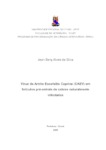Please use this identifier to cite or link to this item:
http://www.alice.cnptia.embrapa.br/alice/handle/doc/925057| Title: | Vírus da Artrite Encefalite Caprina (CAEV) em folículos pré-antrais de cabras naturalmente infectadas. |
| Authors: | SILVA, J. B. A. da  |
| Affiliation: | Jean Berg Alves da Silva. |
| Date Issued: | 2006 |
| Citation: | 2006. |
| Pages: | 144 f. |
| Description: | Resumo: O vírus da artrite encefalite caprina (CAEV) é lentivírus que causa infecção persistente em caprinos de todas as idades. In Vivo, o CAEV infecta preferencialmente células do sistema monocítico-fagocitário, porém já oi identificado em outros tipos celulares, como por exemplo, células epiteliais, endoteliais e nervosas. No trato reprodutivo este vírus já foi identificado no útero, oviduto e ovários de cabras naturalmente infectadas. No ovário o CAEV já foi descrito em células do cumulus oophorus, no entanto ainda não existem pesquisas sobre a presença do agente em folículos pré-antrais. Desta forma o objetivo desta tese foi verificar se o CAEV está presente em FOPA de cabras naturalmente infectadas, além de analisar a viabilidade do uso da criopreservação dos FOPA destes animais para a preservação do seu material genético. Para a identificação do vírus nos FOPA foram coletados 18 ovários sendo oito de cabras soronegativas e dez de soropositivas, foi empregada a técnica de imunohistoquímica e a PCR semi-nested, objetivando verificar a presença de proteínas virais e do DNA proviral, respectivamente. Para a criopreservação foram utilizados os ovários de oito cabras (quatro soropositivas e quatros soronegativas) empregou-se o DMSO 1,5M, como crioprotetor. Após a criopreservação os fragmentos foram fixados e analisados pela técnica de histologia clássica. O DNA proviral do CAEV foi identificado em quatro amostras, sendo duas de córtex e duas de FOPA isolados, porém na imunohistoquímica nenhuma reação positiva foi observada. Nos ovários frescos os animais soropositivos mostraram uma maior (p<0,05) porcentagem de FP degenerados (30,2%) quando comparados aos animais soronegativos (12,5 Após a criopreservação a porcentagem de folículos degenerados aumentou todos os grupos e não foi observada diferença significativa (p<0,05, χ2 ) na t de degeneração entre animais soropositivos e soronegativos. Ficou evide que o DNA proviral do CAEV pode estar presente em FOPA de cab naturalmente infectadas e que oócitos inclusos em FP de cabras naturalme infectadas com o CAEV podem ser criopreservados com uso do DMSO 1 como crioprotetor. Abstract - The Caprine Arthritis Encephalitis Virus (CAEV) cause a persistent infection in goat of all the ages. In vivo the CAEV infect mainly cells of the monocytes-fogocytes lineage, however already were identified in other cellular types, as for example, epithelial, endothelium and nervous cells. In reproductive tract this virus already was identified in the uterus, oviduct and ovaries of goats naturally infected. In the ovary the CAEV was described in cells of cumulus oophorus, however still does not exist research on the presence of the agent in preantral follicles (PF). Of this form the objective of this thesis was to verify if the CAEV is present in PF of goats naturall infected, besides analyzing the viability of the use of the cripreservation of the PF of these animals for the preservation of its genetic material. For the identification of the virus in the PF 18 ovaries were collected, being eight of seronegatives goats and ten of seropositives, it was used the technique of immunohistochemical and hemi-nested PCR, to verify the presence of proteins and the proviral DNA, respectively. For the cryopreservation the ovaries of eight goats had been used (four seronegatives and four seropositives), was used the DMSO 1,5M, as cryoprotectans. After cryopreservation the fragments were fixed and analyzed for the technique of histological examination. To compare difference in the ratio of normal and degenerated preantral follicles between the seropositives and seronegatives animals the test of the χ2 was used, and values were considered estatiscally significant when P<0,05 5%. The DNA proviral for CAEV was identified in four samples, being two of cortex and two of isolated PF, however in the immunohistochemical no positive reaction was observed. In the fresh ovaries the seropositives animals had shown a greater (p<0,05), percentage of degenerated PF when compared with the seronegatives animals. After the ryopreservation the percentage of degenerated follicles increased in all the groups and significant difference was not observed (p<0,05) in the ratio of degeneration between seropositives and seronegatives animals. In conclusion, it was evident that the pro-viral DNA of the CAEV can be present in the PF of naturally infected goats and qu is possible use the cryopreservartion to conserve PF of naturally infected goats, with DMSO 1,5M. |
| Thesagro: | Caprino |
| NAL Thesaurus: | Lentivirus |
| Keywords: | Folículo Pré-Antral |
| Notes: | Tese (Doutorado em Ciências Veterinárias. Área de Concentração: Reprodução e Sanidade Animal) - Universidade Estadual do Ceará, Fortaleza. Orientadora: Maria Fátima da Silva Teixeira; Co-orientador: José Ricardo Figueiredo; Co-orientador: Roberto Soares de Castro; Alice Andrioli, Embrapa Caprinos (CNPC). |
| Type of Material: | Teses |
| Access: | openAccess |
| Appears in Collections: | Tese/dissertação (CNPC)  |
Files in This Item:
| File | Description | Size | Format | |
|---|---|---|---|---|
| CNPC2006VirusdaArtrite.pdf | 649.96 kB | Adobe PDF |  View/Open |









